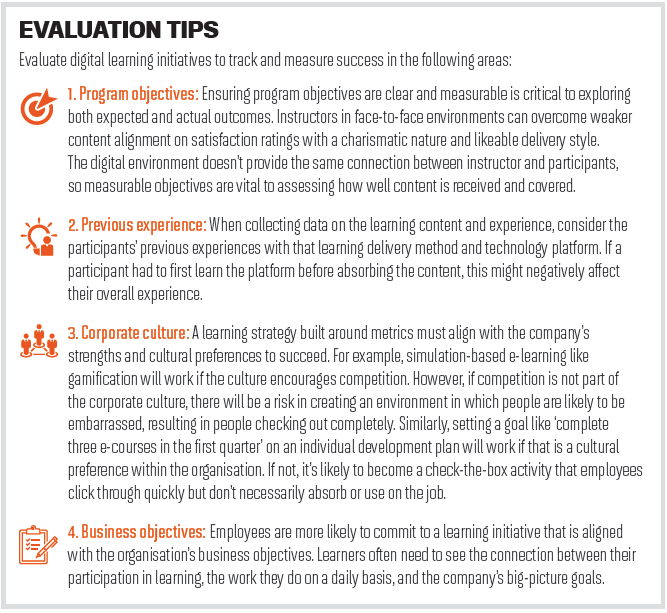Digital learning is more than a convenient way to share information. With the right planning, it can be a cost-effective strategy to deepen workforce and leadership capabilities, write Samir Mehta and Holly Downs
(1).jpg)
Digital learning is more than a convenient way to share information. With the right planning, it can be a cost-effective strategy to deepen workforce and leadership capabilities, write Samir Mehta and Holly Downs
Technology has changed the way corporate learning and leadership development happen across the globe. Organisations increasingly rely on digital learning for a portion of their leadership development and training needs. Whether the delivery method is a massive open online course, a small private online course, virtual instructor-led training, microlearning, blended learning, or other digital tools that allow participants across multiple locations to learn together or independently, it’s critically important to maximise employees’ time and company resources.
However, getting a return from digital learning experiences on an ongoing basis requires far more than just providing a library full of innovative content. Before jumping into developing or reinvigorating a digital learning initiative, learning leaders should consider the following six ways to maximise effectiveness.
1. Embrace the ‘less is more’ principle for online learning
Many organisations pitch their learning initiatives with the concept of having ‘something for everyone’, and then they offer up thousands of choices. These kinds of broad initiatives often lack focus and are rarely successful. Utilisation rates for non-compliance courses, in particular, tend to drop significantly as time passes. To boost utilisation rates and ensure learning efforts are worthwhile, consider employees’ unique needs, and have them set clear goals around challenges they want to address. For instance, what specific leadership skills do they need? What skills do they want based on specific roles or functions? Limit program content based on these needs and wants. Then provide targeted digital learning offerings that align with them.
An example of how the Center for Creative Leadership (CCL) has effectively done this by leveraging technology is CCL Boost*, a minimalist approach to new leader development
2. Enlist and creatively publicise support from the C-suite
To be effective, digital learning initiaives need support from upper management. First, learning leaders must make the business case to senior leadership that time spent on digital learning will lead to new skills that will make employees more efficient and effective long-term. Provide specifics related to established business objectives.
Then provide ways for senior leaders to publicly support the learning program. Videos are typically better received than email. For instance, if a senior leader comes to address a group of learners participating in a face-to-face learning initiative, make a video and then put it on the company’s primary digital learning platform. That support can do a lot to boost participation rates.
CCL leverages its proprietary Learning Platform to capture powerful messages from a C-suite officer in its client organisation. These video messages are often the first message that a digital learner from CCL’s client organisations will see. This makes the learning immediately relevant.
3. Use learner-centric design
Would leaders benefit from a monthly online seminar? Or would a virtual lunch-andlearn program be more effective? Talent leaders must find ways to make learning initiatives a part of the technology employees already use. Having ongoing gaming elements embedded into the experience, such as recognition and competition incentives, can help keep learners engaged and coming back. For example, promote and focus on one leadership topic each month or quarter; couple that with a means of recognising learners’ achievements around specific content offerings, such as a LinkedIn badge. This type of engagement is more likely to be impactful.
CCL’s path-breaking course Frontline Leader Impact* leveraged the design-thinking expertise of IDEO to create a course experience that was learner-centric for the digital age
.
4. Make leaders into teachers
Leadership concepts and behaviours should be reinforced. Learning leaders should ensure that managers get the tools and support they need to become effective coaches, and that they are encouraged to share what they’re learning with their direct reports. To reinforce learning, ask managers to train additional front-line leaders, and have them provide follow-up training modules for skill refreshment.
All learning doesn’t have to be purely digital. CCL’s clients often augment digital learning with leaders leading leaders by leveraging CCL’s Workshop Kits*.
5. Tap into the power of learning partnerships
Learning doesn’t happen just once. Takeaways learned from a webinar or in an interactive session must be practised and refined for employees to retain the information. Establishing accountability partners connects peers who learn together so they can share experiences and discuss challenges and goals. In this way, development experiences create a bond between participants, and they foster an interest in helping each other succeed. This bond also promotes accountability.
CCL leverages the power of learning partnerships using technology. CCL Compass* is a way for learners and coaches or mentors to stay connected on development and actions taken towards specifi c goals in a digital way.
6. Measure what matters
Remember that what gets measured is what gets done. One of the most difficult but crucial ways to determine an initiative’s success is to perform ongoing evaluation. Measurement provides data that can be used to refine and strengthen ongoing digital learning efforts.
Looking at the return on investment and expectations and linking these to top-line business metrics such as sales, retention and promotion rates can be a powerful way to account for program impact beyond participant satisfaction. Further, digital learning initiatives o er data insights such as participation rates and timing that typical face-to-face developmental experiences don’t. Linking these pieces to business objectives can also be informative.
CCL works with its clients in discussing the insights from all the data it collects through every channel available. These insights then guide CCL’s path forward so every dollar spent on development is targeted and impactful.
Sustainable, ROI-driven learning
Technology offers paths for developmental opportunities in real time and across broad geographic locations, and leadershipfocused digital learning and development is growing rapidly. With proper planning, these initiatives o er a cost-e ective way to deepen workforce development to ensure learning is sustained and ROI is delivered.
*For further information, visit www.ccl.org/lead-it-yourself-solutions

Holly Downs is a senior evaluation faculty member at the Center for Creative Leadership’s Evaluation Center









